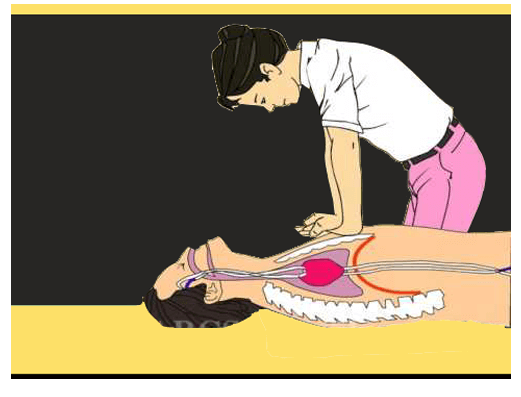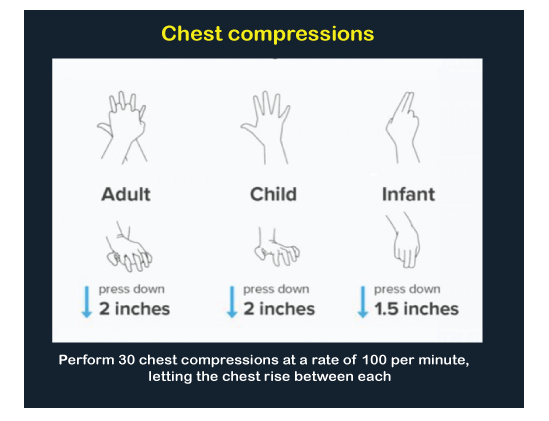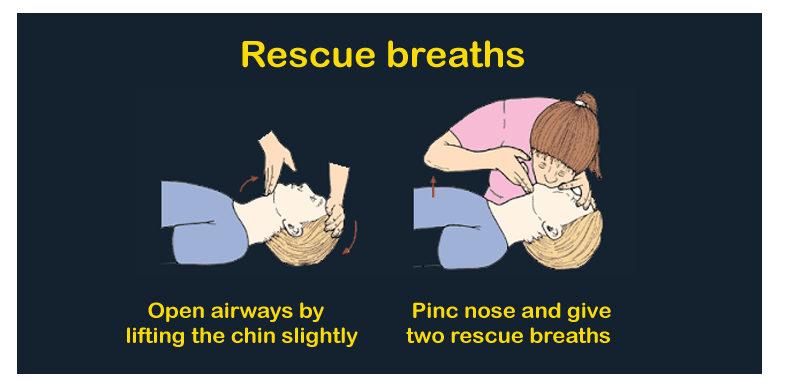CPR-DefinitionCPR stands for Cardiopulmonary Resuscitation. CPR is an emergency lifesaving which is performed when the heart stops beating. Instant CPR (Cardiopulmonary Resuscitation) might double or triple the probabilities of survival after cardiac arrest. CPR (Cardiopulmonary Resuscitation) is a technique used to maintain and restore breathing and circulation and in order to give oxygen and blood flow to the brain, heart and other essential organ. It can be performed by healthcare professionals or trained laypeople on adults, adolescents or infants. It must be performed when an adolescent, adult, infant, or child is not breathing and is unconscious. 
Cardiopulmonary Resuscitation (CPR) is a technique which is used to help and maintain breathing and circulation for adolescent, child or infant who has respiratory arrests and cardiac arrest. The cardiac and respiratory arrest are caused by an ineffective heartbeat, asphyxiation, allergic reactions, breathing passages, which are choking, blocked, drug reactions, drowning etc. In newborns, CPR (Cardiopulmonary Resuscitation) is caused due to failure of the respiratory, which is caused by SIDS sudden infant death syndrome, drowning, neurologic disease, sepsis. The CPR procedures differ for adolescents, children and infants. The two organizations which are American Red Cross and American Heart Association that give CPR training and guidelines, distinguish adolescents, children and infants for the CPR's purpose are as follows:
About High-Quality CPRAnyone can perform the high-quality CPR including bystanders. Following are the main components:
Chain of SurvivalIn the AHA's chain of survival, CPR is an important step. The chain of survival term gives a helpful metaphor for the components of the ECC system concept: In the adult-out-of-hospital chain of survival, there are 6 links:
A solid Chain of Survival can improve possibilities of endurance and recovery for victims of heart failure. What are the Three Parts of CPR?By using the simple word 'CAB,' we can easily remember the basic three parts of the CPR.
CPR Step-by-StepThere are two stages of CPR:
1. Preparation StageWe have to perform the following steps before performing CPR on an adult: Step1. Call 911 First, we have to check the scene for aspects that may put us in a risk. Like falling masonry, fire, traffic, etc., then we have to check the condition of the person like Do they need support? Tap on their shoulder and shout, "Are you alright"? If the person is not answering, then we need to call on the number 911 or ask an onlooker to call on the number 911 before performing CPR (Cardiopulmonary Resuscitation). If there is a possibility, request that an onlooker proceed to search for an AED machine. Individuals can locate these in workplaces and numerous other public buildings. Step 2. Place the individual on their back and open their airway Sensibly, Spot the individual on their back and bow alongside their chest. With their jaws raised, tilt their head back. Open their mouth and check for any obstacle, for example, food or regurgitation. Eliminate any obstacle then loosen it. When it is not loose then try to hold it might push it farther into the airway. Step 3. Check for Breathing Put your ear near to the mouth of the person and listen for close to 10 seconds. In the situation where you do not hear breathing, or you just hear uneven breaths, start CPR. Do not perform CPR in the situation that an individual is still deprived of breathing. Alternately, place them in the position of recovery if they do not suffer spinal cord injury. Continue observing their breathing, and whenever they stop breathing, then performing CPR. CPR StepsThere are various steps to perform Cardiopulmonary Resuscitation (CPR): Step 4. Perform 30 Chest Compressions Spot one hand on top of the other and hold them together. With the impact point of the hands and straight elbows, push fast and hard in the chest's center, marginally underneath the nipples. At least 2 inches deep, we have to push. At a rate of at least 100 times per minute, we need to compress their chest. Allow the chest to fully lift between compressions. 
Step 5. Perform two rescue breaths While making sure that their mouth is clean, tilt their head back somewhat and raise their chin. Close their nostrils, place your mouths totally over their mouth, and jerk their chest up. If with the first breath, their chest does not lift, then retract their head. If the individual still does not lift his chest with a second breath then he may suffocate. 
Step 6. Repeat Repeat this process of two rescues breathes and 30 chest compressions until the individual begin breathing or support arrives. In the situation that an AED arrives, continue doing CPR (Cardiopulmonary Resuscitation) until the machine is set up and prepared to utilize.
Next TopicConstant variable Definition
|
 For Videos Join Our Youtube Channel: Join Now
For Videos Join Our Youtube Channel: Join Now
Feedback
- Send your Feedback to [email protected]
Help Others, Please Share









